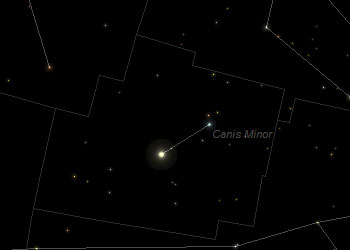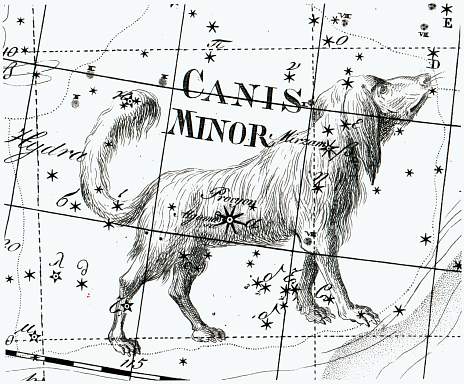Canis Minor
- Gemini
- Unicorn
- Water snake
- Cancer
The Little Dog ( Canis Minor in Latin ) is a constellation north of the celestial equator.
Description
The little dog is a little broad constellation south of the distinctive twins. The main star Procyon is a striking bright, whitish shining star. To the east of the constellation extends the band of the Milky Way. The little dog can be observed in the winter and with the exception of the inner Antarctica anywhere on earth visible.
Mythology and History
The little dog is one of the 48 constellations of the ancient Greek astronomy, which have already been described by Claudius Ptolemy.
He was regarded by the Greeks as a hunting dog and assigned to the Bootes or the Orion.
In ancient times the constellation was, however, only from the main star Procyon. The name means in Greek "before the dog" and refers to the fact that this star rises just before the " Dog Star ," Sirius.
Celestial objects
Stars
The third brightest star in Canis Minor γ, Canis Minoris, is about 200 light years away. He is a red giant star of spectral type K3 with an apparent magnitude of 4.33 m
Double stars
Procyon ( α Canis Minoris ) is characterized by an apparent brightness of 0.40m of achthellste star in the night sky. At a distance of 11.4 light years, it is one of the nearest stars. It is a binary star system. The main star emits a whitish light, is of spectral type F5 to. He is six times brighter than our sun, has a twice as large in diameter and about 40 percent more mass. The companion is a faint white dwarf star, which is only about twice as large as the Earth. The system is difficult to observe because of the bright main star outshines the companion.
The second brightest star in Canis Minor, Canis Minoris β is 150 light years away, much further away. He is a bluish, gigantic double star of spectral type B8.
The name is of Arabic origin and means Gomeisa as much as "the woman with the veiled glance".
14 Canis Minoris is a multiple star system in which three stars move around a common center of gravity. Because of the wide angular distances, the system can be observed already with a lower telescope.
Messier and NGC objects
In Canis Minor are no misty objects that can be observed with low or medium telescopes.








